A Global Perspective on Accessible Transportation in Taiwan
by Beth Finke
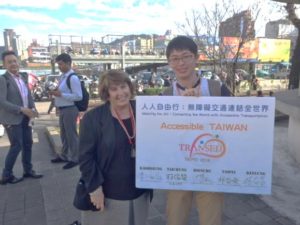
Easterseals’ Judy Shanley (left) with Eden Social Welfare Foundation Host (right) holding a banner acknowledging the commitment of mayors across Taiwan to accessible transportation
I am pleased to have Dr. Judy Shanley here with a guest post today. Judy is the Assistant Vice President of Education & Youth Transition here at Easterseals.
by Dr. Judy Shanley
A non-government funded organization called Eden Social Welfare Foundation promotes support for people with disabilities all over the world. When Eden hosted the 2017 Cooperation Forum on Accessibility and Prosperity in Cities last month, 14 invited professionals from nine countries came to observe accessible transportation modes of major cities in Taiwan. I was one of the two who had come from America.
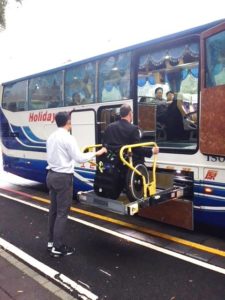
Delegate Peter Cosyn from Belgium Boards Accessible Bus
Our delegation visited five cities to meet with city officials, tour diverse transportation modes, and experience the inclusiveness of mobility options first-hand. From the country’s southern city, Kaohsiung Metro Rapid Transit (KMRT), Kaisyuan Station to the north and Taipei City, Taiwan Railway Keelung Station, to the northern port of Keelung, we listened and learned how the country has been able to build an accessible continuum of transportation services in a very short time. Government officials expressed how a focus on accessibility has affected commerce, economy, community living, and tourism.
One impetus for the increased focus on accessibility and mobility options is the country’s aging population. Demographic statistics released by the Ministry of the Interior show that the 65-and-over population exceeded 2.69 million by the end of 2013. That means older adults are 11.5% of Taiwan’s total population. It’s expected that the population aged over 65 will exceed 20% by 2025.
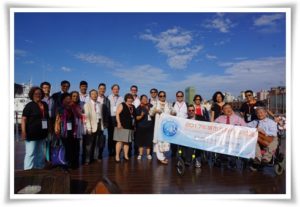
Full International Delegation to the 2017 Cooperation Forum on Accessibility and Prosperity in Cities
Similar increases are evident in the country’s population of people with disabilities. Over 1.17 million people (4.9% of Taiwan’s total population) has a disability. By the end of the forum five city mayors had committed to continuing their focus on accessible transportation and mobility options for their citizens.
Comparative learning — learning from others at the international, national or local levels — is a valuable way to acquire strategies regarding accessible transportation and mobility. In the United States, national programs funded by the Federal Transit Administration enable individuals to learn from each other. I am co-director of one of these programs: the National Center for Mobility Management (NCMM). I am proud of what we do, and I encourage people to tap into the free resources available through projects like NCMM and participate in-peer-exchange forums to share practices.
To learn more about the Taiwan trip or NCMM, just leave a comment here –I’ll be sure to get back to you.
For more articles about accessible transportation, check out:
- Transportation Is Key For People with Disabilities in America
- Tips for wheelchair-friendly train travel
- Learning to teach people to travel independently on public transportation







 Thanksgiving is a joyous family holiday in the United States. From family dinners to football to turkey and pumpkin pie, many Americans enjoy this annual holiday. It may not be “the most wonderful time of the year,” but it’s literally not far from it!
Thanksgiving is a joyous family holiday in the United States. From family dinners to football to turkey and pumpkin pie, many Americans enjoy this annual holiday. It may not be “the most wonderful time of the year,” but it’s literally not far from it!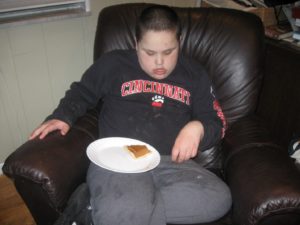
 It took me a while to accept the label “disabled,” even though I’ve been disabled my whole life. I used to think it was a bad word, something to be ashamed of – and that caused internal strife, because I loved who I was. It wasn’t until I met other disabled people that I embraced the identity comfortably and proudly – and I am thankful for having met and befriended these individuals. Even though we live far from each other, we stay connected online; the internet is tantamount to our survival in many ways.
It took me a while to accept the label “disabled,” even though I’ve been disabled my whole life. I used to think it was a bad word, something to be ashamed of – and that caused internal strife, because I loved who I was. It wasn’t until I met other disabled people that I embraced the identity comfortably and proudly – and I am thankful for having met and befriended these individuals. Even though we live far from each other, we stay connected online; the internet is tantamount to our survival in many ways. Thanksgiving week is here once again and it will be the same as it has been since 2000. My dad and I will leave Saint Louis and drive almost 14 hours to go to my aunt’s who lives outside Washington D.C.
Thanksgiving week is here once again and it will be the same as it has been since 2000. My dad and I will leave Saint Louis and drive almost 14 hours to go to my aunt’s who lives outside Washington D.C. Aaron Likens, author of Finding Kansas: Decoding the enigma of Asperger’s Syndrome, and the National Autism Ambassador for Easterseals, has spoken to over 80,000 people at over 900 presentations and has given to the world a revelation of how the Autism Spectrum Disorder mind works. His willingness to expose his inner most thoughts and feelings has unveiled the mystery the Asperger’s mind. Join him on his journey from hopelessness to hope.
Aaron Likens, author of Finding Kansas: Decoding the enigma of Asperger’s Syndrome, and the National Autism Ambassador for Easterseals, has spoken to over 80,000 people at over 900 presentations and has given to the world a revelation of how the Autism Spectrum Disorder mind works. His willingness to expose his inner most thoughts and feelings has unveiled the mystery the Asperger’s mind. Join him on his journey from hopelessness to hope. Young disabled women need to see disabled women in leadership positions – not only in work, but in all aspects of life. Disabled individuals of any gender are already at a disadvantage when it comes to employment, raising a family, fostering relationships, and directing their care. These disadvantages mostly stem from ableism, which is the systematic exclusion of disabled people in society. But within this ableist framework, disabled people continue living; our world doesn’t stop because society says so.
Young disabled women need to see disabled women in leadership positions – not only in work, but in all aspects of life. Disabled individuals of any gender are already at a disadvantage when it comes to employment, raising a family, fostering relationships, and directing their care. These disadvantages mostly stem from ableism, which is the systematic exclusion of disabled people in society. But within this ableist framework, disabled people continue living; our world doesn’t stop because society says so.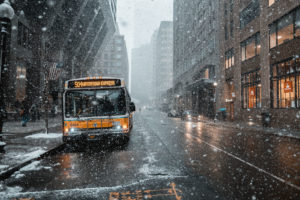 On October 3, WalletHub released its 2017 list of the
On October 3, WalletHub released its 2017 list of the 


 The chill in the air, crunchy leaves on the ground, and ubiquitous pumpkin everything can only mean one thing…. Halloween is nearly here!
The chill in the air, crunchy leaves on the ground, and ubiquitous pumpkin everything can only mean one thing…. Halloween is nearly here!